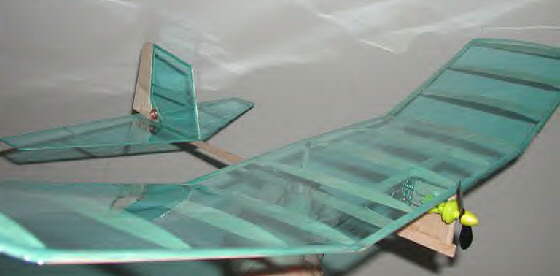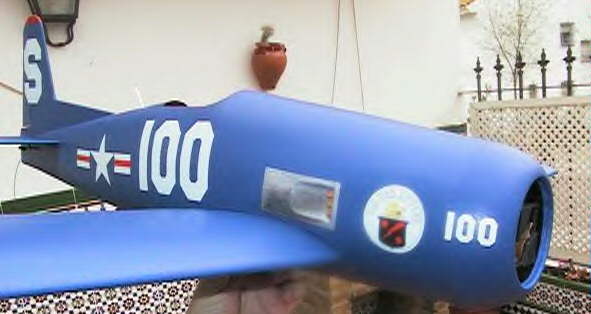 |
Flying High With Electric Power!
The Ampeer ON-LINE!
Fly the Future - Fly Electric! |
Site Table of Contents
| President: | Vice-President: | Secretary/Treasurer: |
| Ken Myers | Richard Utkan | |
| 1911 Bradshaw Ct. | 240 Cabinet | |
| Walled Lake, MI 48390 | Milford, MI 48381 | |
| (248) 669-8124 | (248) 685-1705 | |
 | ||
| Board of Directors: | Board of Directors: | Ampeer Editor |
| Jim McNeely | Jeff Hauser | Ken Myers |
| 4733 Crows Nest Ct. | 18200 Rosetta | 1911 Bradshaw Ct. |
| Brighton, MI 48116 | Eastpointe, MI 48021 | Walled Lake, MI 48390 |
| (810) 220-2297 | (810) 772-2499 | (248) 669-8124 |
| Mailed Ampeer subscriptions are $10 a year US & Canada and $17 a year world wide. FREE on-line! | ||
| The Next Meeting: Date: Saturday, June 2 Place: Midwest R/C Society 5 Mi. Rd. Field Time: 10:00 a.m. | ||
|
By Ken Myers Part 1: March 2001 Ampeer Part 3
The rules of thumb (see noted issues) supply a lot of information about a proposed project, but they still do not answer the question about which power system to use. The rules of thumb only narrow the range of power system choices. While this is basically enough information for a veteran electric flier to have some idea of where to start, it is not enough information to help the beginner to electrically powered flight. Before brushless motors and relatively high discharge rate NiMH (nickel-metal hydride) cells, it was a fairly straightforward process to get an idea of the motor and battery to be used based on the weight of the power system. Unfortunately, the process has become even more complex. Each month in the Ampeer, I will be spotlighting a popular, easily obtainable motor and itís appropriate uses. Whenever possible, real world results will be included with the simulations. The data will also be posted on the EFO site: http://members.aol.com/KMyersEFO. This should make selecting the appropriate power system much easier, once the knowledge base has increased. If part of the aircraft system is already known, such as the weight of a power
system, or the weight of the finished airframe or even the weight of the onboard radio system, the proposed plane can be
"back figured" for the type of plane and performance desired.
(/ means divided by, * means multiplied by - always divide first) Back Figuring Using Finished Airframe Weight If the finished airframe weight is known because it is already completed, the rest of the components can be back figured using the type of aircraft and expected performance. The Carl Goldberg Mirage 550 is used for example, because I am familiar with it. It is a trainer type aircraft and should have moderate performance, therefore itís Flight Factors for predicting target weight is 2 and maximum weight is 2.5. finished airframe weight back figured for the Goldberg Mirage 550
While the above two steps werenít necessary, they do supply some interesting
information. As can be seen above, a 53 ounce flying weight moderate performance type may have a wing area from 410 sq.in.
to 485 sq.in.
This is an interesting result, since the recommended power system of 6 cells and the Turbo 550 motor is only about 19 ounces and their recommended radio system is 9.6 oz. for the 3-channel version. It seems to me that the recommended airborne radio system is too heavy and the recommended power system is too light. In general, this would be an unusual use, but it can be done. A typical "standard" 3-channel airborne radio weight using 3 standard
servos (1.6 oz. each)(Goldberg doesnít use an ESC, just an on/off switch controlled by a servo), a standard receiver (1.4 oz.),
and standard 600 mAh Rx pack (3.6 oz.) = 9.8 oz.
It seems that a "standard" 3-channel airborne radio system is too heavy for this proposed project. Many people have a motor and cells and want to know what it can power.
At 464 sq.in. and with a finished airframe weight of 16 ounces, it appears that the Goldberg Mirage 550 is too big and heavy for this power system to fly it as a moderate performance aircraft. target weight (464 / 144) * (4641/3 * 2) = 49.89 oz. maximum weight (464 / 144) * (4641/3 * 2.5) = 62.36 oz. finished airframe 49.89 * 0.3 = 14.97 oz. to 62.36 * 0.3 = 18.71 oz. airborne radio system 49.89 * 0.15 = 7.48 oz. to 62.36 * 0.15 = 9.35 oz. power system weight 49.89 * 0.55 = 27.44 oz. to 62.36 * 0.55 = 34.3 oz. starting prop diameter (uses the target weight not maximum weight) SQRT ((49.89 * 1.25) / Pi) * 2 = 8.91 rounded to 9 pitch to try would be 6, derived from 9 * .65 = 5.85 rounded to 6 watts out 49.89 / 16 * 45 = 140.32 watts out required RPM (140.32 / ((9/12)4*(6/12)*1.31))1/3 = 8.781 KRPM or 8,781 RPM using a "typical" wooden prop My current rules of thumb differ from Keithís earlier ones as presented in
his "Electric Sport Scale" article. He suggested 40 - 60 watts per pound of input power for mild aerobatics,
which a trainer should be able to do. Using Astro Flight cobalt motors, the range would be approximately 30 watts to 45 watts of
output per pound assuming 75% efficiency. My current recommendation, as shown above, is at the top end of Keithís
range at 45 watts out per pound, so what is the difference? While Keithís recommendation is the top of his range, it is the bottom
end of my recommendation.
This is all nice to know information, but will the motor supplied in the Goldberg 550 kit fly this plane as a trainer type? This monthís motor is the Goldberg Turbo 550. I have two of them; therefore I can test them and give real world results. First, I checked my motor data to see if I had the specs for the motor. I didnít. Next, I went to the MotoCalc database, which is part of the MotoCalc computer program by Capable Computing (www.capable.on.ca) and got the following motor data; Kv = 2528 Io = 2 Ra = .085 Weight = 7.8 ounces. I played around with these numbers on my spreadsheet and said, "Huh! This motor looks too good on paper, compared to how Iíve seen it perform." I weighed the motor. It weighed 6.8 ounces. Humm. I remembered that Bob Kopski had tested this motor and looked up his data in his Model Aviation, July 1989 column, p. 48. He also had two samples of this motor and found; Motor #1 Kv = 2049, Ra = 0.093 and Motor #2 Kv = 2039, Ra = 0.100. The Io was not given. Big difference. There was only one thing left to do, test my motors. I measured the Kv of each of my motors using a reversible drill switched into reverse. I measured the RPM using a digital tack to read the paint lines located 180 degrees opposite each other on the drill collet and measured the voltage with a digital multi-meter for each motor. The average Kv for both motors was 2233. Many tests were conducted over a five-day period, with the meter readings recorded on videotape and played back and paused to get both numbers at the same time. Next the motor resistance was determined by running both motors and measuring the RPM with a digital tachometer, the amps with a digital ammeter and volts with a digital voltmeter, all being recorded on tape, with several tests of each motor taking place. The motor resistance was calculated by dividing the measured RPM by the RPM per volt. The result is the back EMF. The back EMF is divided by the amp draw and yields the resistance. The average resistance for both motors yielded 0.126 ohms. The Io was measured using 4 cells and found to be 1.1 amps on both motors. Both motors had been broken in. My results didnít match either MotoCalc or Bob Kopskiís measurements. I
proceeded with real world results. This is what I measured with an 8x4 Grish prop:
The predictions were within 4% for RPM and 5% for the amp draw; therefore I was convinced that I had close to the correct values for the two particular motors that I have. How I made these predictions can be found later in this section. I decided that I wanted to do a test with a belt-drive and attached the MFA
belt-drive with a ratio of 2.222222:1 to Motor #1. I attached the belt drive and retested for the resistance and Io, since both the
resistance and Io go up when a belt drive is added. The tests yielded the following: Kv = 2233 Ra = .155 Io = 2
10 amps, 0.7 oz., cell resistance = 0.012 15 amps, 1.2 oz., cell resistance = 0.012 20 amps, 1.5 oz., cell resistance = 0.0077 25 amps, 2.0 oz., cell resistance = 0.0077 Motor approximations are just that, but they do help in predicting what a specific
motor might be capable of. The more accurate the input data of Kv, Ra and Io, the more accurate the predictions will be. With
my two motors, the predictions would have been way off, had I not realized that the published data didnít match my motors.
Later Iíll cover again, step by step, how to measure motor constants on the brushed motors that you have. You can find
published motor constants at the EFO site, various sites online and in the "Calc" programs.
Team B-52 Canceled
Regretfully I have canceled the purchase of Chris Golds' beautiful B-52 model and
Team B-52 will return all monetary donations.
2 oz. Indoor R/C for Under $50
Ken, I'm not sure this is something you want for the Ampeer or not, but I've recently
completed an indoor R/C project 'on the cheap' using parts from Wal-Mart and Radio shack. The completed airplane with
transmitter, receiver, motor and airframe cost just around $50. For anyone interested I put up a nice little website documenting
my adventure at: pease1.sr.unh.edu/aew/rc/cannedheat
P-51 & P-47
Thought you might want to see my latest project....
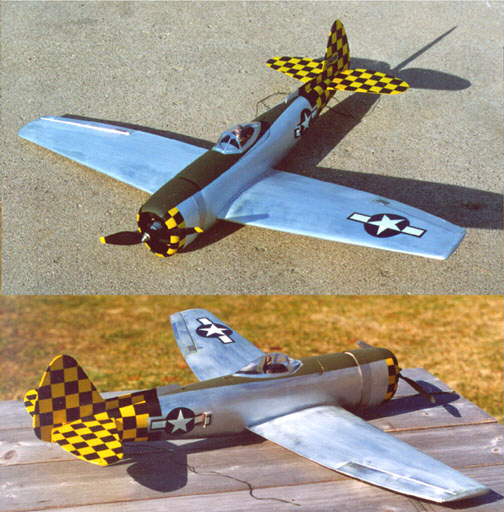 The Jug has same specs and came out at 45 oz FLIES GREAT!!!!! Looking forward to Mid Am again :) Working on Black Widow S400 plans ...... Sanyo CP-1300SCR's are here!!
These cells are 34g or 1.19 oz. with heat shrink (an N-1250SCR is about 40-45g)
and weigh the same as 800AR cells. They are sub-C diameter, but only 1" tall. They are the same technology as the new
RC2400 and perform well at higher currents. I'm going to post some graphs tonight.
Cell Specifications Nominal Voltage 1.2V Typical Capacity at C/5 1300 mAh Impedance at 1000Hz 7.8 mOhm Diameter 23mm Height 25mm Weight 33g
For comparison: N-800AR specs: Weight: 32g Diameter: 17mm Height: 50mm Capacity at 20A: 810 mAh Measured Internal Resistance: 7.8 mOhm My site www.ralphweaver.com MTI products www.magtechinc.net (The new Sanyo CP-1700 cell should be available from various sources in the US by the time you read this. It is a Sanyo cell with about 1700 mAh in a 1250SCR size and weight. KM)
The May EFO Meeting: or our M.I.S.S. Adventure Sunday, May 6, dawned cool and windy. Not the kind of day that we had hoped for!
Although the day was bleak, changing to sunny, the wind changed also, becoming even windier.
The Upcoming June Meeting The June EFO meeting will be a flying one. It will be held at the Midwest R/C Society Flying field located on 5 Mi. Road in Northville Township. The date is set for Saturday, June 2. Any electric fliers in the area are invited to join the EFO members in a day of flying and talking electric flight. An AMA card is REQUIRED to fly. We will be meeting at 10:00 a.m. Should the weather prove to be too foul, the meeting will be on Saturday, June 16, at Midwest. If the weather is "iffy" on June 2, please give Ken a call at 248.669.8124 to see if it is a go or no. North Shore MAC -Auckland NZ-Electric promotion and annual rally
Our club is typical of most here in New Zealand. About 40-45 members and about
25% to 30% of the members are regulars at the field. Unlike most clubs quite a few of the very active members rarely fly
anything but electric powered models. There are another Ĺ dozen who are dabbling and having good success. In other words
most of the active members are flying electric models regularly.
The Herc was built from the plans on the Arieane web site. It had only been finished in the motel the night before!!! The Herc and the team from Hastings got top prize for the effort. These things look so good in the air. It is hard to imagine anything similar being done with IC motors-without a lot more stress and expense. Some really beautiful models. The majority of models were built from plans or own designs. The only competition held was speed 400 pylon racing. Seven entrants. A lot of fun for those competing and the spectators. This was the 1st time the event had been run in New Zealand. As there arenít any National rules we made up a set and circulated them before the rally. We adopted a 100-meter racetrack and flew or tried to fly 10 laps. The winner of race 1 (only one finished) flew against the two who finished in race 2. Paul Lalande, our local Knotronics and Mega supplier put up excellent prizes for the event. Last to go left the field at about 7:00 P.M., a very long hot day. We will do it again next year and would love to host any off shore fliers. Overseas visitors only have to be signed into the visitors book for the day and demonstrate they know what they are doing before they can fly with us!!!! No special license or insurance requirements. Meet Date Change August 18 - tentative Columbus, OH E-meet at the WMAA field just
north of Columbus, Ohio. It will be a fun fly type event, similar to the one that Azarr has put on in the past.
Electric Control Line (ECL) Sport & Stunt
Our AMA Chartered Club #4210 is primarily interested in Electric Control Line
(ECL) sport flying (stunt style) for kids 6 through 18 and youth of ALL ages. We ask you to develop and promote the growth of
ECL!
We believe we are a start in a growing revolution and that ECLís will be flown indoors, in school yards, ball fields, soccer fields, parking lots, and backyards worldwide. What a very rewarding, commercially viable niche market. AndÖ.. Oh, the rewards to our youth! We need a Basic Trainer (now) and Advanced Type RTF/ARFís by next spring. Please advise availability and cost. Will you HELP? Respectfully submitted, George Yatsko - Director Phone: 201 666 4565 fax: 201 722 3876 hiflyers@csnet.net Okay folks, how about some help for George? You can reach him directly as noted above. Grumman BearCat in Spain
Dear Ken, I write from Spain, my name is Diego Lůpez.
Your LT-25
Hi Ken, I do not expect you to remember me, but thanks to you I am slowly getting into this
fine hobby.
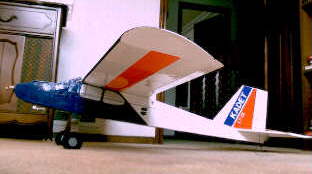 The point of this e-mail is to show you "your LT-25" which as you can see, from the last rebuild has a slightly different nose, ( I had to remake everything including the firewall forward). 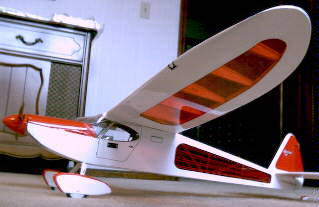 I am proud of the Sig Rascal as it gave me the chance to learn some new building and covering methods. It has an Astro 802G 3.3:1, an APC 8x6 electric prop and 7 Sanyo 600AE cells. NOT FLOWN. But it did win the Shawnee Mission RCC "model of the month" award for March.  The last is an Amptique with a Kontronic BL480-33 brushless motor 4.4:1 gearbox, a 9x5 Graupner slim prop and 7 cells 1250 mAh. I did take your advice and strengthen the rear under and forward of the horizontal stabilizer. Also NOT FLOWN yet! I hope that this has not been too boring, and trust that we will have the chance to meet soon. Mid-America Electric Flies
To Reach Ken Myers, you can land mail to the address at the top of the page. My E-mail
address is:
KMyersEFO@aol.com
|
||||||||||
